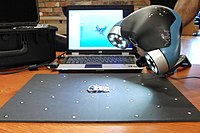
Photo from wikipedia
To provide upper-limb amputees with devices that best fit their needs and to test innovative solutions, it is necessary to quantitatively appraise a device performance with rigorous measurement methods. The… Click to show full abstract
To provide upper-limb amputees with devices that best fit their needs and to test innovative solutions, it is necessary to quantitatively appraise a device performance with rigorous measurement methods. The aim of this work was to define an optimal motion analysis protocol, suitable for optoelectronic systems, to measure the kinematics of poly-articulated hands even when covered by a cosmetic glove. This is a fundamental aspect, because gloves can decrease device speed and range of motion and, ultimately, patients' acceptance of the artificial limb. In this work, different mathematical models of the joints and marker-sets for motion analysis were conceived. A regression model to choose a reduced marker-set for studying the hand performance with different cosmetic glove models was developed. The proposed approaches for finger motion analysis were experimentally tested on the index finger of the i-Limb, a commercial myoelectric poly-articulated prosthetic hand, but the results can be easily extended to the whole hand and to other poly-articulated prosthetic hands. The methods proposed for the performance analysis of prosthetic hands points out that the cosmetic gloves imply a reduction of the finger flexion/extension (F/E) angles and of the motion velocity. This draws attention to the need for performing independent cyclic tests on commercial products with various cosmetic solutions to better guide component selection.
Journal Title: Artificial Organs
Year Published: 2017
Link to full text (if available)
Share on Social Media: Sign Up to like & get
recommendations!